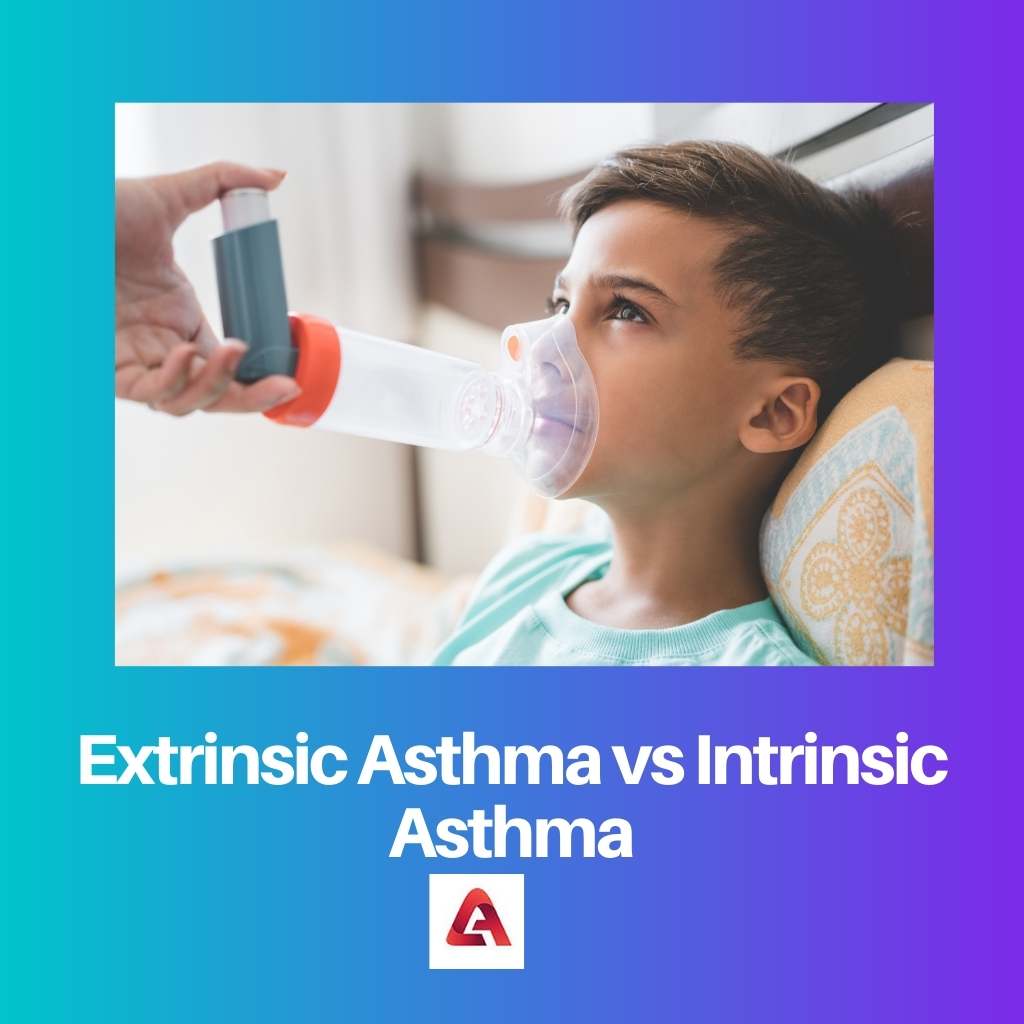Extrinsic and Intrinsic are the two types of asthma that cause breathing issues in people all around the world. These both show similar symptoms but are entirely different in their causes and triggers.
Key Takeaways
- Extrinsic asthma results from external allergens, such as pollen or pet dander, while intrinsic asthma is triggered by non-allergic factors, like stress or cold air.
- Extrinsic asthma develops in childhood, whereas intrinsic asthma tends to appear in adulthood.
- Extrinsic asthma can be effectively managed with allergen avoidance and medication, while intrinsic asthma requires a combination of medications and lifestyle changes.
Extrinsic Asthma vs Intrinsic Asthma
The difference between extrinsic asthma and intrinsic asthma is that extrinsic asthma, also known as allergic asthma, is caused due to some allergic reactions and mostly affects younger people, while intrinsic asthma, known as non-allergic asthma, is caused by smoke, dust, and anxiety, etc., and affect the old age people.

This type of asthma targets the younger generation and is inherited in them from their parents. Extrinsic asthma can be caused by airborne substances or through certain foods and drugs.
It occurs mostly in vagotonic patients with seizure attacks due to the physiological need for oxygen not being provided. Many factors trigger an intrinsic asthma attack which includes cigarettes or wool smoke, perfumes, dust, etc.
Comparison Table
| Parameters of Comparison | Extrinsic Asthma | Intrinsic Asthma |
|---|---|---|
| Definition | Extrinsic asthma is allergic asthma which is associated with certain allergens like dust. | Intrinsic Asthma is non-allergic asthma that is associated with Uncertain stimulants like chemicals. |
| Age group | This type of asthma attacks the old population. | This type of asthma attacks the younger population. |
| Development | Inherited by birth. | Develops later in life. |
| Percentage of cases | . There are 90% of cases registered. | There are 10% of cases registered. |
| Triggers | Triggers for extrinsic asthma include certain foods, drugs or airborne elements, etc. | Triggers for intrinsic asthma include home dust, cigarettes smoke, burning wood smoke, etc. |
What is Extrinsic Asthma?
Extrinsic Asthma, also known as allergic asthma, is caused by some specific allergens, including pollens, dust or pet hair, etc. The symptoms of asthma include coughing when laughing or exercising or at night, finding it difficult to breathe, feeling tightness in the chest, or being out of breath.
Identifying extrinsic asthma is easier as the allergens are known to trigger the body, and asthma is identified.
Even though asthma is next to impossible to get filled and cure. Omalizumab is an antibody that helps reduce extrinsic asthma symptoms by reducing the IgE in the body.
What is Intrinsic Asthma?
Intrinsic asthma, also considered non-allergic asthma, is highly seen in females in their old age and is more severe than other types of asthma. Intrinsic asthma affects the old generation and is developed late in their life.
For the treatment, two sets of medications are available: the long-acting controller medications that need to be taken every day and the short-acting rescue medication taken only when a seizure attack occurs.
Main Differences Between Extrinsic Asthma and Intrinsic Asthma
- Extrinsic Asthma is caused due to natural or environmental elements, whereas chemicals, infections, etc., cause intrinsic asthma.
- Extrinsic asthma shows positive results during a skin prick test, while intrinsic asthma shows negative results.

- https://www.sciencedirect.com/science/article/pii/0954611195901566
- https://www.sciencedirect.com/science/article/pii/0091674973900821

The casual tone of the article, while informative, might undermine the severity and complexity of asthma as a medical condition. A more serious approach could enhance the gravity of the information provided.
The article is very informative and helpful for those who want to understand and differentiate between extrinsic and intrinsic asthma.
The article should dive deeper into the long-term impacts and potential complications of extrinsic and intrinsic asthma. A more comprehensive overview would be beneficial in understanding their overall impact.
It’s important to consider the historical context of treatment methods and the evolution of how extrinsic and intrinsic asthma have been perceived and handled over time.
This article effectively highlights the distinct differences between extrinsic and intrinsic asthma, which is crucial for clear understanding among individuals who might be at risk.
The emphasis on age groups and triggering factors broadens the perspective on asthma beyond just symptoms, giving a more comprehensive understanding.
The comparison table provided is an excellent tool for quick reference, making it easier to understand the contrasts between extrinsic and intrinsic asthma.
While the information is accurate, it fails to address potential misdiagnosis issues that can arise from the similarity of symptoms, which is equally important.